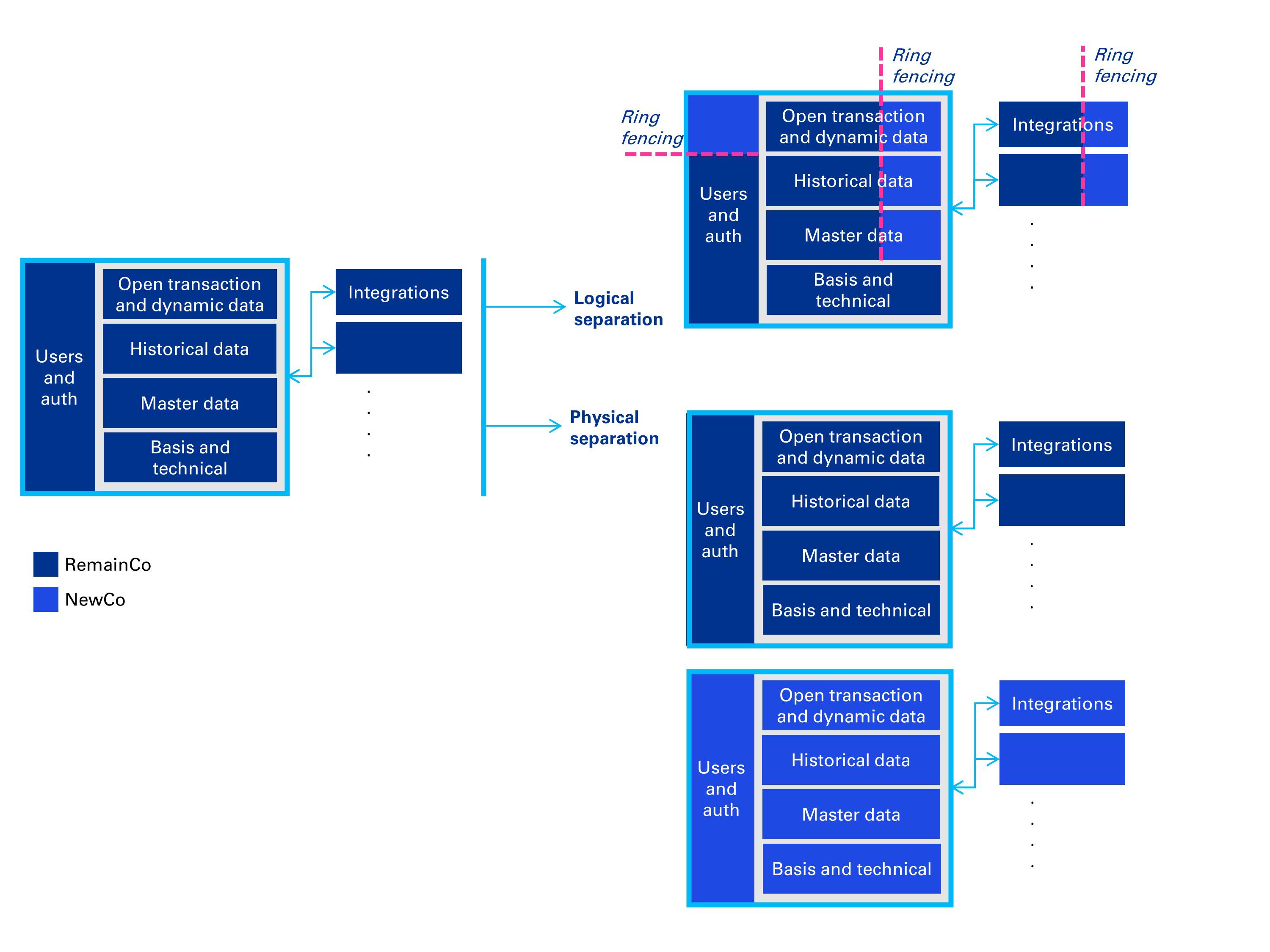Carving out an SAP system is a strategic decision that organizations undertake for a variety of reasons – the predominant one being business restructuring due to a merger, acquisition, or divestiture. Business restructuring has consequences for IT landscapes, leading to the intricate process of carving out IT systems that include SAP.
Carving out an SAP landscape is a not a typical implementation project. The strategy requires mobilizing quickly with the right expertise, a clear and pragmatic approach taking transaction perimeters into account and delivering within the TSA (Transactional Services Agreement) timelines. The process itself demands careful planning with select key stakeholders, meticulous execution, and a comprehensive understanding of both business and technical requirements.
What strategies can be employed to make the agreed carve-out timelines, to effectively address the challenges associated with carving out a segment of a SAP landscape?
SAP Carve-out – Why and Where to start?
Carve-out allows businesses to disentangle intertwined SAP processes, data, and systems inherited from existing entities (RemainCo) and to operate independently with their own SAP systems (NewCo). More often, the objective is to create a standalone operational SAP instance by focusing on required operating model changes across people, processes, data, assets, and contracts. There are cases where the buyer only needs the data to integrate into their ERP system. In both cases, KPMG has the experience, knowledge, and tools for a rapid carve-out to get the right objectives fulfilled.
In terms of preparation, carve-out usually starts prior to the external deal process and is approached through phases to design, plan, and implement the separated SAP instance (depending on the business requirements, this can be a logical separation or a physical separation). The senior leadership of the organization sponsors the program, enabling robust separation plans to be designed and executed as quickly as possible, maximizing the value of the deal while minimizing the impact on the retained company (RemainCo). The separation should evaluate opportunities to create a lean and efficient process that is right for the target business to maximize the deal value.
First things first
The first steps of the carve-out project are all about readiness and what information we need to know before we embark on the carve-out journey. The key topics are:
- What are the timelines? Usually there is a set date for Day 1 (the day when the companies will operate independently) from the transaction side. The SAP team must work backwards to create a pragmatic approach to achieve those timelines. Any delay from Day 1 will result in significant financial and operational issues. All teams should be aware of the Day 1 and its implications.
- Is our Business ready? While the initiative of carve-out might come as a surprise to various business teams, it is important for the organization to identify the Business leads and key users who are crucial for the separation. Business readiness should also identify the key parts of business that have the most and least impact to test the solution effectively.
- What do we need from the Technical team? While business is the priority, technical preparation comes next. This includes system provisioning for sandbox, catering to infrastructure separation requirements (such as licensing and authorizations) and inventorizing the landscape to scope the perimeter of the technical components that will be required for carve-out.
- Is there a competition clause? There could be a competition clause that impacts the IT separations. Consider an approach for handling the confidential data between both buyer and seller for the period of signing to closing the deal. This needs to be addressed between Legal, Finance, R&D, other business workstreams and IT.
- Do we have Trusted advisors? Not all organizations and businesses are exposed to the world of carve-outs. It is crucial to have experienced SAP Carve-out specialists who can bring advice and point solutions to make it work within the timelines.
What is important during an SAP Carve-out?
Three focus areas while executing a carve-out project:
1. People
Carve-out projects bring strain on both the project team and all the impacted employees. Identifying and listening to key stakeholders during the project is important for success. The key measures to be taken during a carve out will include:
- a SteerCo that can hold meetings and make quick decisions during demanding timelines;
- strong Program and Project Management with well-defined and clearly articulated roles and responsibilities;
- a strong Change Management team that reduces the impact on the carve-out and empowers the key stakeholders with clear and timely communications and therefore a steady transition to end state;
- work stream leads and integration leads who are clearly informed on the separation principles and activities from Finance, HR, Tax, Legal, R&D, Manufacturing, Supply chain and IT functions;
- identifying and backfilling the resources by organizations due to the time-sensitive nature of the carve- outs so that day-to-day operations are not hampered while having an unwavering focus towards the carve-out program;
- trusted advisors who will work shoulder to shoulder, bring best practices and an outside-in view for people and processes.
2. Fast and accurate
Speed and accuracy go hand in hand during the carve-out. Speed is determined by the Day-1 implications that will result in expediting the changes around people, process, and technology. Accuracy is important due to the nature of the deal (competitive and confidential data, audit requirements, et cetera). Following are the important steps to ensure we perform a carve-out within the timelines and with good quality of data:
- Set up the key guidelines for the carve-out for both business and technical perspectives. The guidelines should help the workstreams make first-level decisions. They should contain the future enterprise structure, products, customers, and vendors in scope, what it means for the authorizations; will or will there not be historic data in scope, et cetera. It is also good to revisit and affirm these during the project.
- While the nature of the carve-out is fast execution, accuracy of carving out the right data is important. Protecting your IPs, GDRP requirements, and clear agreements on historical data are a few things to keep in mind.
- The separation should be surgical. Not too little or not too much. Just the right amount of data that is required for the standalone organization to be operational.
- While talking about SAP, it is important to emphasize the attention to satellite systems as well. There could be business and operational data in the satellite systems that are important for the carve-out. The line of selection criteria should be uniform across the satellite systems to avoid issues with data and operational issues.
- Tooling and accelerators can make a big difference on carve-outs. Depending on the nature of the data (structured or unstructured), different tooling should be considered. An automated tool reduces human error and should be able to provide automated/preconfigured reconciliations and outputs, which gives the first confidence to business.
- Testing, testing, and testing. For SAP Carve-outs, the principle of testing should be ‘what you do today, you will be doing tomorrow’ (unless there is a business change that is also being performed). Only effective testing (and negative testing) can ensure that the carve-out is surgical.

3. Value and result driven
Both buyer and seller are looking for value in a carve-out. It could be commercial, a strategic step to change the direction of the company due to an acquisition or a divestment. The resulting carve-out should be aligned with the values and meet the objectives of both buyer and seller. SAP as the ERP plays a crucial role in meeting this value and result-oriented objectives.
- The carved-out SAP system should have sufficient and good quality data for the organization to run from Day 1. The objective of all test cycles should be to adhere to Day-1 requirements.
- The Enterprise structure for NewCo (new company codes, lift-and-shift company codes or clone-and-split company codes or other organizational entities such as plants) should address the objectives of the carve-out.
- A clear target SAP architecture (S/4 RISE, On-prem) is also an opportunity for NewCo to start with a clean core without extensive customizations; a chance to adapt and adopt new gen products (MDG, IBP, BTP) and explore the future (Machine Learning/AI) - an opportunity to increase the value of the organization!
- Take a note of customer-specific, customer-differentiating and standard processes while looking at the future state. They need to be given special emphasis during testing and training. This is one of the areas where a carve-out can be made business/operation friendly and not just a legal/strategy decision.
Expert guidance
Separation projects require specific SAP expertise. KPMG experts know carve-out projects. We understand SAP systems, how carve-outs work and expectations and the impact of the transaction on both the buying and selling side. More importantly, KPMG’s trusted advisors can identify priorities and understand what is needed to manage a successful carve-out project.
Our three differentiating pillars are:
1. A pragmatic, proven approach – Powered
Powered takes a ‘solution-led’ approach to transformation. It comprises a combination of pre-built solution assets, delivery assets & tools and a delivery method for faster, lower-risk implementation of the solution and realization of benefits. The carve-out timelines are much smaller compared to the traditional approach and are powered by our consultants and specifically designed tools and accelerators.
2. Our tools and accelerators
The KPMG NL team have performed over multiple SAP Integration and Separation projects for over a decade. The knowledge and the experience have resulted in our customized repository of tools and accelerators. The KPMG Carve-out toolkit consists of predefined blueprints (workshops will start with predefined blueprints), industry-specific selection criteria and SAP object criteria, and a defined automation approach.

3. The right mix of experience and expertise on all process and technical disciplines
Our SAP consultants come with the wealth of experience in leading, designing and educating customers on SAP carve-out projects. The experience extends beyond SAP and discussing the requirements and provides clarity to M&A, legal, HR, Tax, Finance, and other disciplines.
Stay informed?
Would you like to stay informed about new publications, insights and reports related to SAP? Leave your contact details in the form below and you will automatically receive the latest publications in your mailbox.



